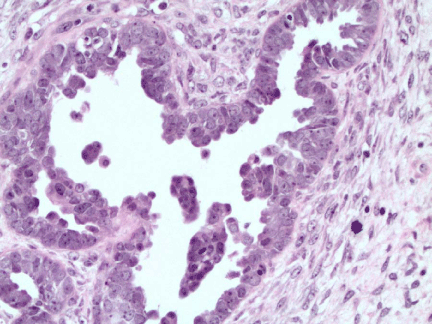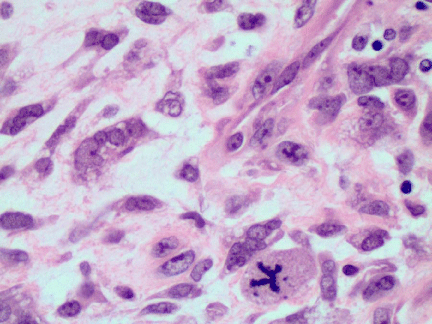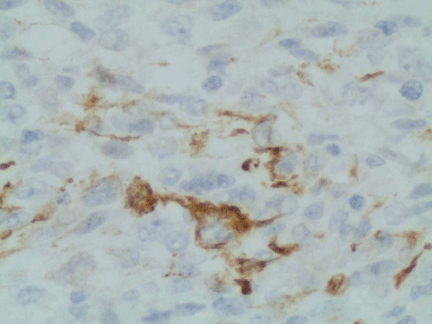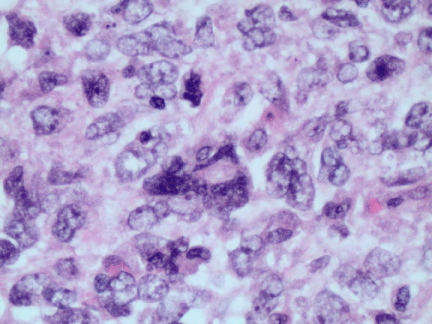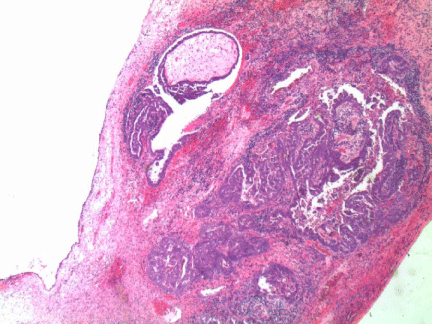Case Report
Uterine Carcinosarcoma in A BRCA2 Mutation Carrier
Petersen SS1, Quigg MH2, Zhang Z3 and Buekers T4*
1Department of Women's Health Services, Henry Ford Hospital, USA
2Department of Medical Genetics, Henry Ford Hospital, USA
3Department of Pathology, Henry Ford Hospital, USA
4Division of Gynecology Oncology, Department of Women's Health Services, Henry Ford Hospital, USA
*Corresponding author: Thomas E. Buekers, Division of Gynecologic Oncology, Department of Women's Health Services, Henry Ford Hospital, 2799 West Grand Boulevard, K9 Detroit, Michigan, 48202, USA
Published: 14 Oct, 2016
Cite this article as: Petersen SS, Quigg MH, Zhang Z, Buekers T. Uterine Carcinosarcoma in A BRCA2 Mutation Carrier. Clin Oncol. 2016; 1: 1111.
Abstract
Background: Uterine carcinosarcoma is one of the most aggressive uterine cancers, with 5-year survival for advanced stage disease of 30%. Currently, there is no optimal standard chemotherapy
regimen for uterine carcinosarcoma and most patients suffer from disease recurrence.
Case Presentation: A 68 year-old Ashkenazi Jewish woman was diagnosed with stage IIIC2 uterine
carcinosarcoma after presenting with abdominal pain. Although uterine carcinosarcoma is not
currently associated with any genetic syndrome, her ancestry and family history of breast cancer
prompted genetic screening. She was found to be a carrier of the BRCA2 mutation. After surgical
resection and chemotherapy with carboplatin/paclitaxel, she had complete response and has had
disease free survival for over 23 months.
Conclusion: We report prolonged disease free survival of uterine carcinosarcoma in BRCA2 mutation carrier.
Introduction
Uterine carcinosarcomas, also known as malignant mixed mullerian tumors, are comprised of both epithelial and mesenchymal components [1]. Carcinosarcomas are aggressive tumors
representing 5% of uterine malignancies and are responsible for 16% of uterine cancer deaths [1]. Radiation therapy and tamoxifen use are known factors associated with development of uterine
carcinosarcoma [2,3]. Uterine carcinosarcoma has not been associated with a genetic syndrome.
A review of PubMed publications with keywords uterine carcinosarcoma, BRCA2, BRCA1
and tamoxifen revealed two reports of patients with uterine carcinosarcoma and BRCA mutation.
One patient with a BRCA2 mutation had a diagnosis of uterine carcinosarcoma with a history of
tamoxifen use [4]. Another study identified two patients with BRCA1 related breast cancer who
subsequently developed uterine carcinosarcoma in the absence of tamoxifen use [5]. Here we
describe the first patient with BRCA2 mutation and diagnosis of uterine carcinosarcoma without
history of exposure to tamoxifen.
Case Presentation
A 68 year old Ashkenazi Jewish woman presented with complaints of abdominal pain, anorexia,
and alternating diarrhea and constipation. She also reported significant fatigue and a six-pound
unintentional weight loss. Evaluation led to a diagnosis of irritable bowel syndrome and the
patient was treated with minimal relief. The patient then presented with symptoms of progressive
constipation. She underwent further evaluation with a CT of the abdomen and pelvis revealing a
large uterine mass compressing the sigmoid colon. Pelvic ultrasound showed a 16 cm uterus with
cystic areas. She was referred to a gynecologic oncologist, whose examination revealed a 16-week
size uterus with nodularity and no adnexal masses.
The patient underwent an exploratory laparotomy and intraoperative findings included a large
mass appearing to originate from the ovary adherent to the cul-de-sac, sidewalls and sigmoid colon
mesentery. Frozen section favored sarcoma, therefore, she had a total abdominal hysterectomy
with bilateral salpingo-oophorectomy, omentectomy, pelvic and para-aortic lymph node sampling
and peritoneal biopsies. Cytology of the peritoneal washings was negative for malignancy and final
pathology revealed carcinosarcoma arising from the uterine fundus (Figure 1 and 2a) with metastases
to both ovaries (Figure 3) and left fallopian tube (Figure 4). Pathologic examination revealed
the mass originating from the uterine fundus containing both sarcomatous and carcinomatous histologic components, confirmed with immunohistochemical
staining of desmin (Figure 2b), vimentin, CD10 and AE1/AE3. The
right ovary was completely replaced with tumor predominately
composed of myxoid sarcomatous components and right fallopian
tube was negative for malignancy.
The left ovary, left fallopian tube and bilateral pelvic lymph
nodes and left para-aortic lymph nodes were positive for metastatic
adenocarcinoma yielding a final diagnosis of Stage IIIC2 grade 3
carcinosarcoma of the uterus. Following optimal surgical resection
of the tumor, the patient underwent combination chemotherapy with carboplatin and paclitaxel for 3 cycles then pelvic radiation therapy followed by an additional 3 cycles of carboplatin and paclitaxel
therapy.
Evaluation of the patient’s family history revealed a maternal
aunt with breast cancer diagnosed in her fifth decade. No other
family history of cancer was reported. Due to her Ashkenazi Jewish
ancestry, family history of breast cancer and personal uterine cancer
diagnosis, though atypical for the BRCA1/2 mutation, she elected to
have a sample sent for genetic testing. She was found to be a carrier
of the BRCA2 5946delT (6174delT) mutation, one of three founder
mutations in the Ashkenazi Jewish population.
Figure 1
Figure 1
Carcinoma element of uterine tumor: Malignant glands form
papillary fronds and exhibit high grade serous morphology with markedly
nuclear pleomorphism and prominent nucleoli.
Figure 2a
Figure 2a
Sarcomatous element of uterine tumor: Malignant cells form
sheets with little cytoplasmic differentiation. They show bizarre high grade
nuclei with brisk mitotic activities; some demonstrate rhabdoid morphology
with eosinophilic cytoplasm.
Figure 2b
Figure 3
Figure 3
Tumor metastasis to ovaries: Mainly composed of sarcomatous
element, identical in morphology to sarcomatous portion of uterine tumor.
Figure 4
Figure 4
Tumor metastasis to fallopian tube wall: Composed of malignant
glands with high grade serous morphology, identical to carcinoma element
of uterine tumor.
Discussion
Uterine carcinosarcoma has been associated with BRCA2
mutations in patients with prior exposure to tamoxifen [4]. The case
presented here provides evidence of the first uterine carcinosarcoma
associated with germline BRCA2 mutation in the absence of tamoxifen
exposure. Although this case of uterine carcinosarcoma may be
sporadic, the patient’s prolonged disease free survival after being
treated with platinum based agents may be a result of her germline
BRCA mutation-related hypersensitivity to platinum chemotherapy
agents.
Studies by the Gynecologic Oncology Group found efficacy of
adjuvant chemotherapy in uterine carcinosarcomas with regimens
of ifosfamide and cisplatin; paclitaxel and carboplatin; and
ifosfamide and paclitaxel [6,7]. However, the optimal chemotherapy regimen has not yet been demonstrated. Our patient, who received
adjuvant chemotherapy with paclitaxel/carboplatin and interval
radiation therapy, has progression free survival of 23 months since
chemotherapy. Her survival exceeds the median reported survival of
16 months of a phase II trial of carboplatin and paclitaxel in women
who received adjuvant therapy for unmeasurable disease [8]. Of
note, long-term survival after complete response to cisplatinum and
ifosfamide has been reported in a patient with BRCA2 tamoxifen
associated uterine carcinosarcoma [4].
It is important to note that assigning the site of origin for a
tumor involving multiple contiguous organs is difficult. This usually
relies on assessment of relative tumor volumes and in some cases
histopathologic evidence of premalignant lesions demonstrating
transition to malignancy. In the case presented, the pattern of
distribution was consistent with uterine origin with bilateral ovarian
and left fallopian tube metastases. The possibility of synchronous
ovarian tumors or mullerian field effect could not be completely
excluded and it is noted that ovarian carcinosarcoma has been
associated with BRCA2 mutation in one case report [9]. However, it
is important to note that although the right ovary was replaced by
sarcomatous tumor, the right fallopian tube and right para-aortic
lymph nodes did not contain malignancy, a finding that does not
support a right ovarian primary malignancy in this patient.
This case report is the first to suggest an association of BRCA2
mutation with uterine carcinosarcoma in absence of tamoxifen
exposure. Further studies are needed to determine the prevalence
of BRCA mutations in uterine carcinosarcomas and whether loss of
heterozygosity is present in these tumors. If further studies support an
association between uterine carcinosarcoma and BRCA2 mutations,
concomitant hysterectomy at the time of risk-reducing bilateralsalpingo-
oophorectomy in women with known BRCA2 mutations
may be considered.
References
- Artioli G, Wabersich J, Ludwig K, Gardiman MP, Borgato L, Garbin F. Rare uterine cancer: carcinosarcomas. Review from histology to treatment. Critical reviews in oncology/hematology. 2015; 94: 98-104.
- Meredith RF, Eisert DR, Kaka Z, Hodgson SE, Johnston GA Jr, Boutselis JG. An excess of uterine sarcomas after pelvic irradiation. Cancer. 1986; 58: 2003-2007.
- Olah KS. Uterine carcinosarcoma in association with tamoxifen therapy. British journal of obstetrics and gynaecology. 1997; 104: 1420.
- Clara A, Fonseca I, Francisca A, Bettencourt A, Vaz F. Unexpected long-term survival in a BRCA2 patient with metastatic carcinosarcoma associated with tamoxifen. Gynecologic oncology case reports. 2013; 4: 44-46.
- Wilson BT, Cordell HJ. Uterine carcinosarcoma/malignant mixed Mullerian tumor incidence is increased in women with breast cancer, but independent of hormone therapy. Journal of gynecologic oncology. 2015; 26: 249-251.
- Wolfson AH, Brady MF, Rocereto T, Mannel RS, Lee YC, Futoran RJ, et al. A gynecologic oncology group randomized phase III trial of whole abdominal irradiation (WAI) vs. cisplatin-ifosfamide and mesna (CIM) as post-surgical therapy in stage I-IV carcinosarcoma (CS) of the uterus. Gynecol Oncol. 2007; 107: 177-185.
- Powell MA, Filiaci VL, Rose PG, Mannel RS, Hanjani P, Degeest K, et al. Phase II evaluation of paclitaxel and carboplatin in the treatment of carcinosarcoma of the uterus: a Gynecologic Oncology Group study. J Clin oncol. 2010; 28: 2727-2731.
- Lacour RA, Euscher E, Atkinson EN, Sun CC, Ramirez PT, Coleman RL, et al. A phase II trial of paclitaxel and carboplatin in women with advanced or recurrent uterine carcinosarcoma. Int J gynecol cancer. 2011; 21: 517-522.
- Sonoda Y, Saigo PE, Federici MG, Boyd J. Carcinosarcoma of the ovary in a patient with a germline BRCA2 mutation: evidence for monoclonal origin. Gynecol Oncol. 2000; 76: 226-229.

